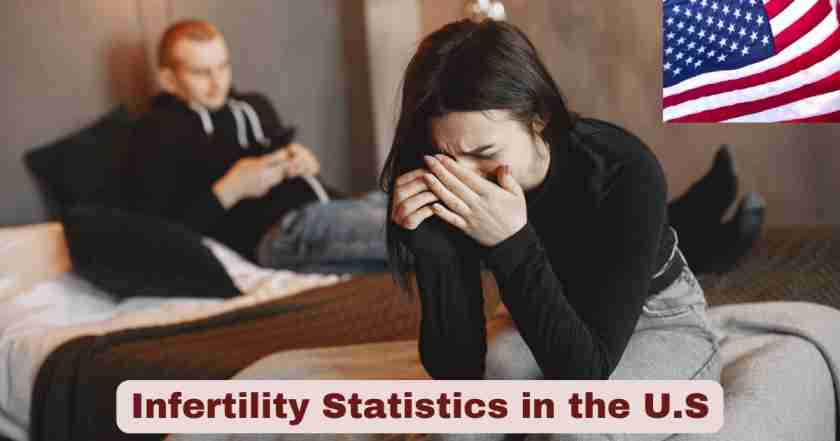Infertility in the U.S.
Infertility has become a growing concern across the United States, affecting millions of couples and individuals in their journey to parenthood. Based on the latest data from the Centers for Disease Control and Prevention (CDC), approximately 13.4% of women ages 15-49 experience impaired fecundity, highlighting the widespread nature of this reproductive health challenge. The landscape of fertility in America continues to evolve as more people delay childbearing, seek medical intervention, and navigate the complex emotional and financial aspects of fertility treatments.
The statistics surrounding infertility paint a picture of resilience and determination, with countless families turning to medical advances and support systems to achieve their dreams of parenthood. Recent data indicates that 42% of Americans have either sought fertility treatment themselves or know someone who has, demonstrating how common fertility challenges have become in modern society. Understanding these statistics is crucial for healthcare providers, policymakers, and individuals who are making informed decisions about their reproductive health and family planning goals.
Interesting Facts About Infertility in the U.S. 2025
| Fact Category | Key Statistics | Additional Details |
|---|---|---|
| Global Impact | 1 in 6 individuals worldwide experience infertility | This represents approximately 17% of the global population |
| Treatment Awareness | 42% of Americans have used fertility treatments or know someone who has | Shows the widespread nature of fertility challenges in U.S. society |
| Pregnancy Success by Age | 25-year-old women have 18% chance of pregnancy per cycle vs 7% for 40-year-old women | Demonstrates significant age-related fertility decline |
| IVF Growth | 91,771 babies born from IVF in 2022, up from 89,208 in 2021 | Represents continued growth in assisted reproductive technology |
| Egg Freezing Surge | 29,000+ women froze eggs in 2022 vs only 475 in 2009 | Shows dramatic 61x increase in egg preservation |
| Male Factor Contribution | One-third of infertility cases are due to male factors | Emphasizes that infertility affects both partners equally |
| PCOS Impact | 90% of anovulation cases are caused by PCOS | PCOS affects 5-10% of women of childbearing age |
| Miscarriage Risk | 20% risk at age 35 increases to 57-80% by age 45 | Shows dramatic increase in pregnancy loss with maternal age |
Infertility continues to affect a significant portion of the U.S. population in 2025, reflecting both global patterns and uniquely American trends. With 1 in 6 individuals worldwide experiencing infertility, it has become a common medical and emotional challenge for many families. In the United States, 42% of people have either used fertility treatments or know someone who has, highlighting the growing visibility and normalization of reproductive assistance. Age plays a critical role in fertility outcomes: while a 25-year-old woman has an 18% chance of conceiving per cycle, this drops to just 7% by age 40, underscoring the time-sensitive nature of fertility and prompting many to consider early interventions like egg freezing, which has surged from just 475 cases in 2009 to over 29,000 in 2022.
The data also reveals that infertility is not solely a female issue—male factors contribute to one-third of all infertility cases, pointing to the importance of comprehensive evaluation for both partners. Conditions like polycystic ovary syndrome (PCOS) are a leading cause of anovulation, responsible for 90% of such cases, and affecting 5–10% of women of childbearing age. Additionally, the risk of miscarriage climbs steeply with age, with a 20% chance at age 35 rising to as high as 80% by age 45. Meanwhile, the use of assisted reproductive technologies like IVF has grown steadily, with over 91,000 babies born via IVF in 2022 alone. These figures reflect the rapid advancement and increasing reliance on fertility treatments while emphasizing the need for early education, access to care, and supportive reproductive health policies.
Female Infertility Statistics in the U.S. 2025
| Category | Percentage/Rate | Population |
|---|---|---|
| Impaired Fecundity Overall | 13.4% | Women ages 15-49 |
| Impaired Fecundity by Birth History | 13.8% (no births) vs 13.1% (1+ births) | Women ages 15-49 |
| Married Women Impaired Fecundity | 16.3% | Married women ages 15-49 |
| Married Women by Birth History | 26.0% (no births) vs 14.1% (1+ births) | Married women ages 15-49 |
| Infertility in Married Women | 8.5% | Married women ages 15-49 |
| Primary vs Secondary Infertility | 19.4% (primary) vs 6.0% (secondary) | Married women ages 15-49 |
| Infertility Services Usage | 12.2% | Women ages 15-49 |
| Couples Unable to Conceive | 19% | Married women with no prior births |
Female infertility statistics reveal significant patterns related to age, marital status, and reproductive history. The data shows that married women without children face the highest rates of fertility challenges, with 26% experiencing impaired fecundity compared to 14.1% of those with previous births. This disparity highlights the importance of early fertility assessment and intervention for couples struggling with primary infertility.
The statistics also demonstrate that nearly 1 in 5 married women with no prior births are unable to conceive after a full year of trying, representing a substantial portion of the population seeking to start families. Additionally, 12.2% of all women ages 15-49 have used infertility services at some point, indicating the widespread need for reproductive medical care. These numbers underscore the importance of accessible fertility treatments and comprehensive reproductive health services for women across all demographic groups.
Male Infertility Statistics in the U.S. 2025
| Category | Percentage/Rate | Population | Key Details |
|---|---|---|---|
| Overall Male Infertility | 11.4% | Men ages 15-49 | Some form of infertility (subfertility or sterility) |
| Prime Reproductive Years | 12.8% | Men ages 25-49 | Slightly higher rate in prime reproductive years |
| Contribution to Couple Infertility | 33% | Couples with infertility | One-third of cases due to male factors |
| Azoospermia (No Sperm) | 10-15% | Infertile men | Complete absence of sperm |
| Azoospermia General Population | 1% | All men | Affects 1% of total male population |
| Varicocele in General Population | 15% | All men | Enlarged veins in testicles |
| Varicocele in Primary Infertility | 25-35% | Men with primary infertility | Much higher rate in infertile men |
| Varicocele in Secondary Infertility | 50-80% | Men with secondary infertility | Even higher in secondary infertility |
Male infertility statistics reveal that reproductive challenges affect over 1 in 10 men, with 11.4% of men ages 15-49 experiencing some form of fertility issues. The data becomes more concerning when examining men in their prime reproductive years, where 12.8% of men ages 25-49 face fertility challenges. This indicates that male fertility issues are not uncommon and play a significant role in overall couple infertility.
The statistics highlight varicocele as a major contributor to male infertility, affecting 15% of all men but impacting 25-35% of men with primary infertility and an alarming 50-80% of men with secondary infertility. Additionally, complete absence of sperm (azoospermia) affects 10-15% of infertile men, though it represents only 1% of the general male population. These numbers demonstrate that male factors contribute substantially to fertility challenges, emphasizing the need for comprehensive evaluation of both partners when couples experience difficulty conceiving.
Age-Related Fertility Decline in the U.S. 2025
| Age Group | Pregnancy Rate Per Cycle | Miscarriage Risk | Chromosomal Abnormality Risk |
|---|---|---|---|
| 20 years | Not specified | Lower risk | 0.2% |
| 25 years | 18% (after 3 months trying) | Lower risk | Not specified |
| 30 years | Not specified | Lower risk | 0.3% |
| 35 years | Not specified | 20% | Not specified |
| 40 years | 7% (after 3 months trying) | 33-40% | 1.6% |
| 45 years | Not specified | 57-80% | Not specified |
| 49 years | Not specified | Not specified | 15% |
Age-related fertility statistics demonstrate the dramatic impact of maternal age on reproductive outcomes. The data shows that pregnancy rates decline significantly with age, with 25-year-old women having an 18% chance of conception per cycle compared to only 7% for 40-year-old women. This represents a 61% decrease in fertility between ages 25 and 40, highlighting the importance of age in family planning decisions.
Miscarriage risk increases exponentially with maternal age, starting at 20% at age 35 and rising to 57-80% by age 45. Similarly, chromosomal abnormality risk escalates dramatically, from 0.2% at age 20 to 15% by age 49. These statistics emphasize why fertility experts recommend that women over 35 seek evaluation after just 6 months of trying rather than the standard 12 months for younger women. The data underscores the biological reality of age-related fertility decline and the importance of early intervention for optimal reproductive outcomes.
Assisted Reproductive Technology (ART) Statistics in the U.S. 2025
| ART Category | Numbers/Rates | Success Rates | Trends |
|---|---|---|---|
| IVF Cycles 2022 | 389,993 cycles | 6% increase from 2021 | Continued growth in IVF utilization |
| IVF Babies Born 2022 | 91,771 babies | Up from 89,208 in 2021 | 2.9% increase in IVF births |
| First IVF Cycle Success | 33% | Get pregnant during first cycle | One in three couples succeed initially |
| Cumulative IVF Success | 54-77% | Get pregnant by eighth cycle | Most couples eventually succeed with persistence |
| Donor Egg Cycles | 12% | Of all IVF cycles use donor eggs | Significant portion involves egg donation |
| Gestational Carrier Usage | 2% | Of all ART cycles | Approximately 4,000 births annually |
| Embryo Donation | 2,000+ embryos | 40.6% live birth rate per cycle | Thawed for IVF annually |
The assisted reproductive technology statistics reveal a thriving and growing field that continues to help thousands of families achieve their dreams of parenthood. IVF utilization increased 6% from 2021 to 2022, with 389,993 cycles performed resulting in 91,771 babies born. This represents a 2.9% increase in IVF births and demonstrates the continued expansion of fertility treatment access and success.
Success rates for IVF remain encouraging, with 33% of couples achieving pregnancy during their first cycle and 54-77% succeeding by the eighth cycle. The data also shows the importance of donor programs, with 12% of all IVF cycles using donor eggs and 2% involving gestational carriers. These statistics highlight how advanced reproductive technologies provide multiple pathways to parenthood for couples facing various fertility challenges. The 40.6% live birth rate for embryo donation demonstrates that even donated embryos can provide excellent outcomes for families seeking alternative paths to conception.
Fertility Treatment Trends in the U.S. 2025
| Treatment Type | Usage Statistics | Success Rates | Notable Trends |
|---|---|---|---|
| Conventional Treatments | 85-90% of cases | Medication/surgery based | Most infertility treated conventionally |
| IUI Success Rate | 10.9% per cycle | 19.4% across multiple cycles | Lower success but less invasive |
| Egg Freezing Growth | 29,000+ women in 2022 | 61x increase since 2009 | Dramatic growth in fertility preservation |
| Average Age First Birth | 30 years | Highest on record | Women delaying childbearing |
| Female Workforce Participation | 75% of women ages 25-54 | Up from 67% a decade ago | Career focus driving egg freezing |
| Sperm Donation Motivations | 48% want to help others | 85.7% willing to meet offspring | Altruistic motivations predominate |
| Treatment Cost Impact | $15,000+ typical cost | Usually not covered by insurance | Major financial barrier for many couples |
Fertility treatment trends reveal a landscape where conventional medical therapies remain the primary intervention, treating 85-90% of infertility cases through medication or surgery. However, assisted reproductive technologies are experiencing unprecedented growth, with IVF cycles increasing 6% annually and egg freezing showing explosive 61-fold growth since 2009.
The average age of first birth reaching 30 years represents the highest in U.S. history, driven by 75% of women ages 25-54 participating in the workforce compared to 67% a decade ago. This shift toward later childbearing has fueled the dramatic increase in fertility preservation, with over 29,000 women freezing eggs in 2022. Despite advancing success rates, fertility treatments remain expensive at $15,000+ and typically lack insurance coverage, creating significant financial barriers for many couples seeking to build their families.
Disclaimer: The data research report we present here is based on information found from various sources. We are not liable for any financial loss, errors, or damages of any kind that may result from the use of the information herein. We acknowledge that though we try to report accurately, we cannot verify the absolute facts of everything that has been represented.







